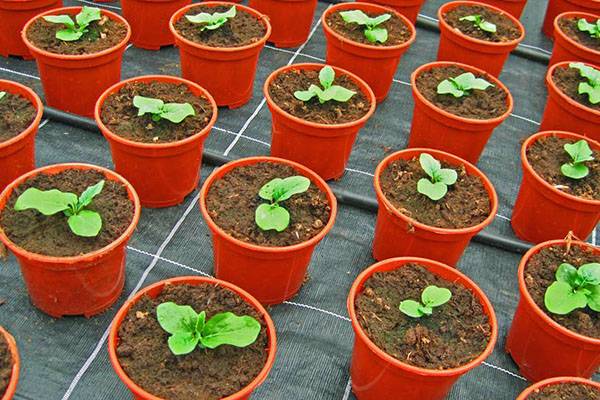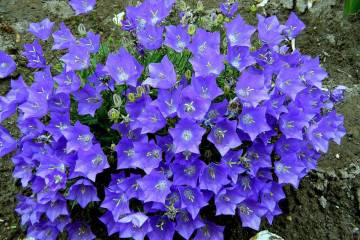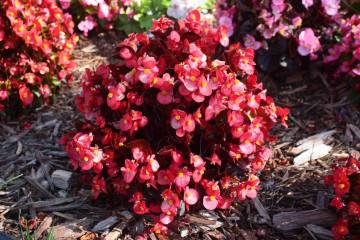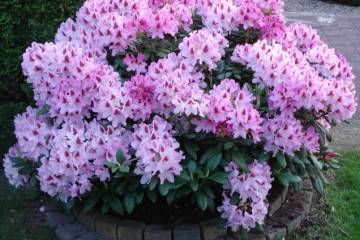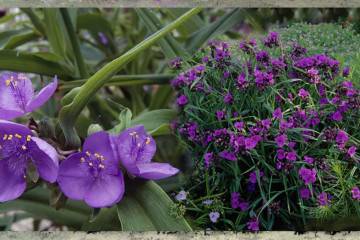Garden gerbera - how to grow in the garden
Content:
Unusual, bright, beautiful, reminiscent of a chamomile, gerbera is loved by many flower growers. Many colors have always attracted garden owners. If you study all the whims and conditions for caring for this capricious flower, then the summer cottage can be decorated with luxurious and elegant islets of gerbera bushes.
Brief description and history of origin
The garden gerbera belongs to the Compositae family, or Astrovykh. Gerbera - perennial or annual? This flower is considered a perennial herb.
The flower bushes are small, the foliage has a feathery shape with cuts and a glossy surface, framed in a rosette near the very root. The length of the bushes is about 35 cm. Sometimes there is pubescence at the base. The length of the stems is 30-60 cm, the basket of inflorescences is large. When opened, the flower has a diameter of 12 to 17 cm. Depending on the variety, the flowers are simple, semi-double or double. The flowering period is March-November. The homeland of the plant is Africa, Madagascar, tropical Asia.
Varieties and popular varieties
Many do not know if gerberas are perennials or annuals. There are many hybrids, varieties, and both. Florists use separation by appearance:
- semi-double;
- terry;
- with small flowers;
- with large flowers and wide leaves;
- with large flowers and narrow leaves.
Jamson
This species is considered the most suitable flower for the garden. The herbaceous perennial has a large bush. Slightly raised, long (up to 20 cm) plumose foliage, sometimes with slight pubescence, is collected in a socket. Peduncle of large diameter, not very high. The inflorescence reaches 10 cm in diameter. The flowering period is long (up to 3 weeks).
Wright
Lobate or feathery leaves with whole, sometimes serrated edges. The long peduncle has a chamomile-like flower. Depending on the variety, the inflorescences are colored red, orange, purple, yellow, pink. The middle is yellow or white.
Abyssinian
Perennial reaching 45 cm in height. Elliptical leaves form a rosette. The plate is 22 cm long, 14 cm wide, the edges are wavy or notched-finely toothed. A young leaf is covered with a light downy. Inflorescences are solitary, apical. The flowers are ligulate, painted white, but sometimes have reddish tints. This gerbera will be a decoration in any garden.
Alcor
It is distinguished by a large inflorescence up to 13 cm in diameter and narrow long petals. The peduncle is high - 70 cm. The color is orange-yellow.
Aldebaran
Elliptical leaves form a rosette. Low bush with a thick root. Single basket inflorescences are colored orange, bright red, pink, dark scarlet and yellow. The flowers can be black or dark purple with a white stripe in the middle. Such gerberas will be an adornment in any country house.
Gerberas in the garden: growing and care
Garden gerbera is a thermophilic plant, so the planting site should be protected from the wind and well lit.
You need to plant a flower in a high bed in order to exclude stagnation of moisture and the accumulation of groundwater, which can lead to decay of the root system. The soil is prepared loose and nutritious with a drainage system.
The pits for the bush should be of medium size in order to calmly transfer the seedling root with an earthen lump there. The neck of the root is left 2 cm above ground level. The distance between the bushes when planting in the ground is left about 20 cm.
Seat selection
The choice of a place for planting gerberas is an important criterion, since in the absence or lack of lighting, it will not bloom. Provide the flowers with the required amount of bright light.
In order for the flowering of gerbera to be accompanied by large and bright inflorescences, you need to be guided by the following criteria when choosing a planting site:
- light areas of growth;
- places closed from the wind.
How to prepare the soil and seedlings for planting
Step-by-step instruction:
- From January to March, you can sow seeds for seedlings.
- Prepare the soil by mixing turf and leafy soil with humus and sand in a ratio of 2: 1: 1.
- Place the seeds 2-3 mm deep and wait for shoots to appear in 2 weeks.
- When 2-3 true leaves appear, the seedlings are transplanted into separate pots.
- Transplanting seedlings into open ground is carried out when the night frosts have passed.
How to care for a perennial
Despite the relative unpretentiousness, growing gerberas has its own subtleties that any grower needs to know.
Watering rules and humidity
Watering should be done in small portions, but often. During the period of active development, watering is done abundantly, after flowering more than moderately, following the moisture at the roots.
Watering is necessary, observing the following rules:
- stagnation of water should not be allowed;
- water must not be allowed to enter the rosette of leaves and leaf plate;
- use of warm water: in winter - 16-20 ° С, in summer - 26-27 ° С;
- 1 m² of flower garden consumes 25 liters of water.
Top dressing and soil quality
Once within 2 weeks from March to early autumn, the plants must be fed, preferably with mineral fertilizers. The best option for gerbera is a complex mixture for flowering crops.
The preferred soil for gerberas is nutritious, well-drained and low in acidity. In gardening stores, you can buy specialized soil for gerberas or roses, but you can make a soil mixture for a flower garden yourself. To do this, mix in equal proportions deciduous turf, peat and drainage (sand or perlite).
Pruning and replanting
It is produced after the beginning of flowering. It is necessary to carry out sanitary cleaning by removing dry leaves and stems directly. It is recommended to cut the extra leaves in the outlet, this technique stimulates the appearance of new flowers.
Repotting is a great way to rejuvenate a mature plant. At the time of transplantation, an adult bush can be divided into several small ones. For this, the rhizome of the dug plant is cleaned of soil, carefully divided with a disinfected blade or a sharp knife into 2 parts. The cut is treated with powdered charcoal or ash, and before it begins to dry out, the seedlings are planted in a new place and watered abundantly.
Winter gerbera care
A perennial plant grown from seeds and planted with seedlings in open ground can delight with its flowering for several years.When grown in regions with not very cold winters, you need to prune dried stems at a level of 10 cm from the soil, and cover the bush with straw or dry leaves. However, it is worth monitoring the temperature, since in warm weather, the bush is likely to undergo podoprevanie.
In regions with cold winters, it is recommended to dig home gerbera bushes for the winter and transplant them into pots for wintering in a warm, bright room with good ventilation. The air temperature in it should be 6-10 ° C.
Features of flowering plants
The flower has baskets located on long peduncles, up to 60 cm, without leaves. The diameter of gerbera inflorescences depends on the variety. There are also small flowers - up to 4 cm, and large - 30 cm. The inflorescence is collected from 2 types of flowers. Gerbera blooms from mid-spring to autumn.
Flower reproduction methods
Planting and caring for a garden gerbera also implies the possibility of its reproduction. In addition to sowing seeds for seedlings, gerbera can be propagated by dividing the bush. The advantages of this method include:
- it turns out a lot of bushes;
- the flower acquires resistance to diseases;
- the plant develops rapidly.
Reproduction by dividing the bush
Algorithm of actions, how to grow gerberas by dividing a bush:
- Dig out the bushes and divide them into 2-3 divisions, so that each one has shoots and roots.
- Make the rhizomes shorter, about 15 cm long.
- Treat the sections with activated carbon.
- Plant in shady areas in early summer.
Seed propagation
Gerberas are flowers, which not all gardeners know how to grow from seeds. Simple step by step instructions:
- Sow the seeds in a seedling pot filled with a nutritious soil consisting of peat and sand.
- Water the plantings and cover with cling film.
- Provide an air temperature of at least 25 ° C and timely watering.
- When seedlings appear, the temperature must be lowered to 20-22 ° C.
- When two or three true leaves appear, the plants must be transplanted into separate pots.
- You can land on the street only when it gets stronger and reaches 10-15 cm in height.
Growing problems, diseases and pests
Garden gerbera is quite susceptible to diseases and pests. Many diseases arise from care errors. The soil must be treated before planting in order to avoid fungal diseases of the root system.
The most common gerbera diseases:
- powdery mildew. May appear due to improper watering and excess moisture. Symptoms - the leaves wither, turn yellow, become stained and whitish. If this disease is detected, the plant must be treated with a fungicide or preparations containing sulfur. In the most advanced cases, diseased leaves must be removed;
- gray rot. A characteristic gray bloom appears, and the leaves begin to fade. Can be prevented if treated in a timely manner with a special compound.
Among the pests from which gerberas suffer are whitefly, aphids and spider mites. You can remove them with special drugs.
Growing gerberas outdoors is not a very difficult process. The main thing is to provide them with proper care and take into account all the nuances of wintering. These flowers will bloom for a long time and profusely, decorating a flower bed, balcony, terrace or veranda.



